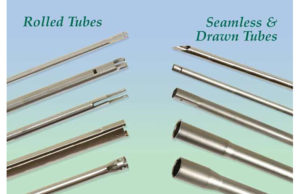
Hospitals’ need for single-use surgical instruments may spike as they resume elective procedures following the worst of COVID-19. Outsourcing with a credible tubing partner allows OEMs to focus on core competencies internally and free up other resources for maximum competitive advantage.
Jim Jock, Micro
As elective surgeries resume during this time of COVID-19, hospitals will be gearing up to stock their shelves with medical instruments to help meet the demand. Single-use surgical devices such as scissors, graspers, forceps, and dissectors will be in high demand due to their inherent benefit of reducing spread of infection.
One of the most critical components of these instruments is the shaft, which must meet strict diameter requirements while housing critical-to-function subassemblies. Most often, these shafts are made from stainless steel tubing, which may be manufactured from drawn tubing or using an innovative stamped-and-rolled technique. Features and volume help to determine which approach will be better suited to a given project.
The tubing approach
Drawn tubing allows for better control of some features such as straightness or diameter consistency, particularly when tightly controlled dimensions are required throughout the entire length of the metal tube shaft. This method of tubing also produces a more robust result when creating specific end features such as expansions or reductions, flaring and flanging, and end sharpening. In addition, drawn tubing facilitates other processes, such as piercing and slotting, precision sharpening, electropolishing and laser welding, coupled with customer assemblies and environmentally friendly cleaning systems.
Rolled tubing is a revolutionary process in which a “rolled” tube is manufactured using a progressive stamping die, allowing for a finished tube to drop off a high-speed press at a rate of one per second. Features such as windows and slots can be added in the flat blank stage, before being “rolled” into a finished tube. Rolled tube technology is best suited for high-volume orders such as those greater than 300,000 pieces. This approach to tubing helps to reduce production time, component costs and secondary operations for the manufacturing of endoscopic subassemblies. Innovative technologies such as rolled tubing can provide a cost-effective and efficient way to achieve more advanced features such as holes, slots and windows on larger-volume projects.
Design for manufacturability
For OEMs that need to rapidly bring products to market during the COVID-19 pandemic, design for manufacturability (DFM) will be essential. DFM provides an effective approach to identifying any issues or product challenges as early as the design stage. For design engineers, the pressures are expected to be even higher, because they face cost targets, time-to-market and other factors.
DFM can help cut down on the number of times additional prototype iterations are required and help to smooth out the manufacturing process by removing unwarranted steps, which saves on production time, costs, and reduces the likelihood of a miscommunication or breakdown in communication. There is less wasting of significant resources, all while speeding up time to market. Finally, DFM helps to prevent the risk of “under-designing” a product which could lead to functional issues or “over-designing” a product, which could result in the inability to manufacture efficiently.
Experienced partner
OEMs that need to act quickly to meet demand should work with contract manufacturer organizations (CMOs) that offer a variety of cost-effective, high-quality tubing solutions. An experienced partner can help with producing the most cost-effective and efficient product that will be profitable. OEMs and their CMO partners must collaborate, especially early in the development cycle to ensure a product can be manufactured in a way that meets the OEM’s goals. A successful partnership is essential for ensuring quality and value in product development and production. Situations such as this prove that value is not only about the lowest price.
Given the economic, technological, and regulatory pressures of today’s medtech market, OEMs understandably look for ways to decrease development cycles, production time and costs to maximize value and profitability. Outsourcing with a credible partner is one viable option, as it allows companies to focus on core competencies internally and free up resources that fall outside their core competencies for maximum competitive advantage.
Jim Jock is marketing coordinator for Micro. He joined the company in 2001 and has been involved with the metal stamping and manufacturing industry for more than 40 years.
The opinions expressed in this blog post are the author’s only and do not necessarily reflect those of Medical Tubing and Extrusion or its employees.